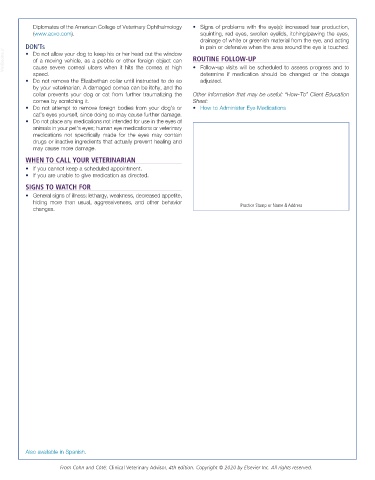Page 2967 - Cote clinical veterinary advisor dogs and cats 4th
P. 2967
Diplomates of the American College of Veterinary Ophthalmology • Signs of problems with the eye(s): increased tear production,
(www.acvo.com). squinting, red eyes, swollen eyelids, itching/pawing the eyes,
drainage of white or greenish material from the eye, and acting
DON’Ts in pain or defensive when the area around the eye is touched.
VetBooks.ir of a moving vehicle, as a pebble or other foreign object can ROUTINE FOLLOW-UP
• Do not allow your dog to keep his or her head out the window
• Follow-up visits will be scheduled to assess progress and to
cause severe corneal ulcers when it hits the cornea at high
speed. determine if medication should be changed or the dosage
• Do not remove the Elizabethan collar until instructed to do so adjusted.
by your veterinarian. A damaged cornea can be itchy, and the
collar prevents your dog or cat from further traumatizing the Other information that may be useful: “How-To” Client Education
cornea by scratching it. Sheet:
• Do not attempt to remove foreign bodies from your dog’s or • How to Administer Eye Medications
cat’s eyes yourself, since doing so may cause further damage.
• Do not place any medications not intended for use in the eyes of
animals in your pet’s eyes; human eye medications or veterinary
medications not specifically made for the eyes may contain
drugs or inactive ingredients that actually prevent healing and
may cause more damage.
WHEN TO CALL YOUR VETERINARIAN
• If you cannot keep a scheduled appointment.
• If you are unable to give medication as directed.
SIGNS TO WATCH FOR
• General signs of illness: lethargy, weakness, decreased appetite,
hiding more than usual, aggressiveness, and other behavior
changes. Practice Stamp or Name & Address
Also available in Spanish.
From Cohn and Côté: Clinical Veterinary Advisor, 4th edition. Copyright © 2020 by Elsevier Inc. All rights reserved.

